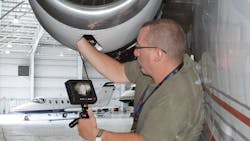Clearly, A New Perspective
With constant improvements to resolution and image quality of miniature complementary metal–oxide–semiconductor (CMOS) sensors, used largely for the cell phone market, Gradient Lens Corporation is applying the same technology to develop their own miniature borescope cameras.
The Hawkeye V3 HD Video Borescopes are the new, high-definition, articulating video borescopes used for aircraft engine inspections. They utilize high-definition (HD) CMOS sensor technology, HD daylight readable touchscreen display and advanced image processing.
Launched in January 2020, Gradient Lens currently offers four models of the V3 scopes, including both the 4mm and 6mm diameters, each available in lengths of 1.5m or 3.0m. Longer lengths will be available in the future.
“Because of the constant improvement, it allowed us to develop and manufacture HD 4mm videoscopes with the best image quality on the market today, at roughly half the price of the major U.S., Japanese and German competitors,” said Dr. Doug Kindred, president and chief scientist of Gradient Lens. “We also utilize the latest display technology, with our 5.5-inch, high-brightness, daylight-readable HD touchscreen.”
The combination of the HD CMOS micro camera, the HD touchscreen display and the IMX6 image processor produces sharp, clear, vibrant images with excellent resolution, contrast and color rendition.
“The image quality is absolutely superb,” Kindred noted. “The Hawkeye V3 HD Video Borescopes also features WiFi capability to view images on iPhones and iPads, as well as sophisticated image processing software, center and edge weighting and glare reduction features.”
The V3s have a bright, integrated LED light, servo-driven joystick operated articulation and a six-hour battery life. Optional accessories include, 90-degree close focus tips, a stand, neck strap, rigidizer tubes and a spare battery,” Kindred explained. “We are currently developing 6m and 8m long scopes that can be used for airframe inspection.”
The latest technology and driving force behind the borescopes are the HD CMOS sensors. “They offer great quality at reasonable prices,” Kindred said. “Ditto for the touchscreen display technology, WiFi capability and even software interface being very similar to a smart phone, with features like, ‘pinch to zoom’ for images, mirror images, swiping through image files, etc.”
These scopes do not require calibration, which makes operating a breeze. “Training for using the borescopes are minimal because the user interface is so intuitive that it is very easy to use,” Kindred said.
So, what factors should be taken into consideration when thinking about buying borescopes? Kindred says Buy American. The borescopes created by Gradient Lens are manufactured in the USA. “I can’t emphasize that enough, because this allows us to fully-control every aspect of the manufacturing and quality control, as well as provide better service to our customers.
“There are many scopes on the market, different brands, offered by all sorts of companies who do don’t make them; they import them,” Kindred added. “The Hawkeye V3 Video Borescopes are super-high-quality, with the best image quality on the market at a great price, with the latest technology. They are incredibly awesome scopes.”
Kindred said the V3 scopes are well-constructed and, as such, are reasonably durable. However, something to keep in mind is everything that is going on in the 4mm diameter scopes. “You have a tiny 2mm diameter HD camera with lenses, circuit boards and all with fiber optics for illumination and tiny vertebrae for the articulation, attached to tungsten guide wires,” Kindred explained. “The entire thing is then encased in a polymer sheath, then surrounded with a stainless-steel mono-coil for crush resistance, then another poly layer, then covered with tungsten braid for durability and abrasion resistance.”
A few tips to get the most out of the scope: Don’t crush it, don’t articulate it too far, don’t get it stuck and don’t yank it out — you might break it, he said.
“Don’t close the case lid on the scope, that’s the most common way people destroy their scopes,” Kindred explained. “Keep the lens at the tip clean and be careful with the scope and you’ll get great performance and lots of life out of it.”
The first Hawkeye Borescopes where invented in 1995. Now, Gradient Lens manufactures and sells more than 80 models of Hawkeye borescopes, with top-notch optical quality, construction, value and overnight delivery.
About the Author
Eavan McGrath
Assistant Editor
Eavan McGrath originates from northern Illinois and is a graduate of UW-Whitewater. There she studied professional writing and publishing, creative writing and marketing. Eavan began her career with an internship in healthcare, developing marketing skills, writing and communications skills as the internal and external communications intern for the immunology and oncology team for AbbVie. She moved on to developing media content for a landscaping company called James Martin Associates, writing blogs and social media content as the creative content writing intern. Here she plans to continue advancing her skills in writing, marketing and editing as an assistant editor with the Endeavor Aviation Group.

